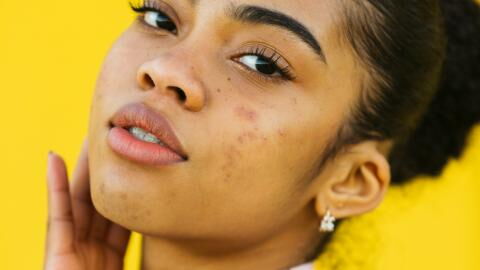Imagine the feeling of relief, your acne has finally started to subside, and your face no longer feels the punishing pain of inflammation. But the battle isn’t over yet; severe acne can often leave behind pigmentation and scarring that is both emotional and physical.
Discover our latest podcast
The types of scars left behind by acne can be atrophic or hypertrophic, with one being pitted and the other being raised.
What is atrophic scarring?
If you’ve popped a particularly large and inflamed pimple or suffered a breakout of nodule/cystic acne, then you may be left with some atrophic scars. The inflammatory processes involved in acne often lead to the degradation of collagen fibres and subcutaneous fat beneath the skin. The body then fails to regenerate this lost tissue, leading the lesion to heal below the skin’s outer layer. This chain of events creates atrophic scaring, which appears as pits or holes in the skin.
Types of atrophic scarring
Atrophic scars can occur from acne, chickenpox, skin picking or even from having a mole removed and can be separated into three subtypes:
Icepick scars
Icepick scars are long and narrow and appear to the eye like a very deep pore.
Boxcar scars
Boxcar scars are wider than they are deep and have well-defined edges. And, just like the name, these types of atrophic scars are often box-shaped.
Rolling scars
Rolling scars are similar to boxcar scars in terms of width and depth, but they don’t seem to have well-defined edges or shapes. Instead, rolling atrophic scars resemble a rolling hillside.
How to treat atrophic scars
There is a myriad of scar treating creams on the market, most of which contain hyaluronic acid, cocoa butter and vitamin E. But while these ingredients may claim to reduce the appearance of scars in some small studies, large scale trials have yet to show effective results.
Instead, those suffering from atrophic scars should see a dermatologist for recommendations on treatment and recovery. Keep in mind that dermatologist treatments for atrophic scars are largely successful, but there is always a small risk that the treatment may leave a new scar.
Laser resurfacing
Laser resurfacing can be used to treat all types of acne scars. Laser skin resurfacing is a procedure that uses an intense beam of light that can either burn off the outer layer of the skin - to reduce the appearance of scars - or it can warm the skin to encourage healing.
Chemical peels
Chemical peels are a standard treatment for atrophic acne scars. The process works by shedding the damaged layer of the skin through the controlled use of strong chemical exfoliants. This then generates a new layer of skin underneath to reduce the appearance of superficial scars.
The chemicals used in this type of treatment can vary depending on the severity of scarring. Everyday exfoliants like glycolic acid are often used in a high concentration to treat more mild atrophic scars. In contrast, deeper chemical peels often use phenol, which requires sedation before being applied.
Fillers
Fillers are often used for rolling scars and can provide immediate results. Soft tissue fillers such as hyaluronic acid can be injected underneath the skin’s surface to raise the indented scars.
Skin needling therapy
Skin needling therapy, otherwise known as microneedling or dermarolling, is the process in which a dermatologist rolls needles over the face in multiple directions. These needles cause hundreds of puncture to the skin to trigger collagen production and regeneration.
Atrophic scarring will then be reduced when these tiny punctures heal as there is enough collagen to restore the skin evenly.
Punch excision
Punch excision treatments are relatively common for atrophic icepick scars. During this procedure, the dermatologist takes a needle the size of the scar and cuts out the scar tissue. Then, the doctor will close the wound with stitches to allow it a chance to reheal properly. If the scars are more significant, a tiny skin graft is taken from behind the ear to fill the wound.
Subcision
Subcision is one of the best methods to treat atrophic rolling scars but is often used in conjunction with other treatments.
Subcision involves loosening the skin around the scar and creating a new wound to trigger proper healing. During a subcision, a needle is inserted under the skin around the scar repeatedly in all directions. After the needling, ice and pressure will then be applied to the new wound to prevent bleeding. Subcision can be a one-off treatment but may be done multiple times if needed.















